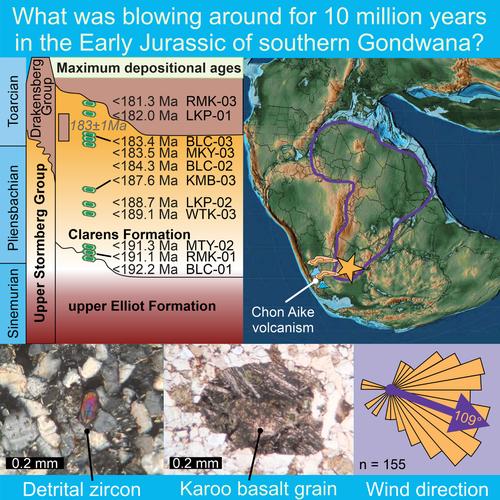当前位置:
X-MOL 学术
›
Basin Res.
›
论文详情
Our official English website, www.x-mol.net, welcomes your
feedback! (Note: you will need to create a separate account there.)
Sedimentation tempo in an Early Jurassic erg system: Refined chronostratigraphy and provenance of the Clarens Formation of southern Africa
Basin Research ( IF 2.8 ) Pub Date : 2024-06-14 , DOI: 10.1111/bre.12877 Howard V. Head 1 , Emese M. Bordy 1 , Robert Bolhar 2
Basin Research ( IF 2.8 ) Pub Date : 2024-06-14 , DOI: 10.1111/bre.12877 Howard V. Head 1 , Emese M. Bordy 1 , Robert Bolhar 2
Affiliation

|
The Clarens Formation is a widespread aeolianite deposited over southern Gondwana and represents the final phase of erg evolution in the main Karoo Basin during the Early Jurassic. Previous age assessments of the formation hinge on limited detrital zircon data, supplemented by relative ages from the biostratigraphy and geochronology of the adjacent Karoo units. This study refines the depositional history of the Clarens Formation, including its sediment source dynamics as well as basin-wide geochronological framework, based on U–Pb dating of detrital zircon grains, together with petrographic and sedimentological characterization. The abundant presence of heavy minerals like zircon, tourmaline and rutile suggests large-scale detritus recycling, while the uniform sandstone composition on a regional scale is an indication of sediment homogenisation across the basin. Based on the prominent detrital zircon age fractions, the sediments are interpreted as having been reworked from pre-existing rocks of the Karoo Supergroup (Permian), the Damara and Saldania Orogenic belts (650–490 Ma), whereas minor sources can be assigned to the Namaqua-Natal Mobile Belt (1.35–1.1 Ga) and the western Sierras Pampeanas (1.30–1.33 Ga). Unstable minerals (hornblende, garnet, titanite, feldspar) provide evidence for a nearby granitic source east and southeast of the basin, related to likely Grenvillian rocks (1.0–1.3 Ga). An Early Jurassic zircon age fraction is linked to volcanic activity in the Chon Aike Magmatic Province that, at the time, was situated south and southwest of the study area. Maximum depositional ages derived from these detrital zircon dates suggest that the sedimentation of the Clarens Formation spanned an interval of ~10 Ma during the Pliensbachian and early Toarcian. More specifically, the lower part of the formation is of early Pliensbachian age or younger (~191–192), while the upper part is of early Toarcian age or younger (~181–183 Ma). These age patterns are particularly prominent in the south of the basin that was situated closer to the volcanic source.
中文翻译:

早侏罗世 erg 系统中的沉积速度:精细的年代地层学和南部非洲克拉伦斯组的起源
克拉伦斯地层是冈瓦纳大陆南部沉积的广泛分布的风成岩,代表了早侏罗世主要卡鲁盆地的尔格演化的最后阶段。先前对地层的年龄评估取决于有限的碎屑锆石数据,并辅以邻近卡鲁单元的生物地层学和地质年代学的相对年龄。这项研究基于碎屑锆石颗粒的 U-Pb 测年以及岩石学和沉积学特征,完善了克拉伦斯组的沉积历史,包括其沉积物源动态以及全盆地的地质年代框架。锆石、电气石和金红石等重矿物的丰富存在表明大规模的碎屑回收,而区域范围内均匀的砂岩成分表明整个盆地的沉积物均质化。根据显着的碎屑锆石年龄分数,沉积物被解释为是由卡鲁超群(二叠纪)、达马拉和萨尔达尼亚造山带(650-490 Ma)的预先存在的岩石改造而成,而次要来源可归因于纳马夸-纳塔尔移动带 (1.35–1.1 Ga) 和潘皮纳斯山脉西部 (1.30–1.33 Ga)。不稳定矿物(角闪石、石榴石、钛矿、长石)为盆地东部和东南部附近的花岗岩源提供了证据,可能与格伦维尔岩石 (1.0–1.3 Ga) 有关。早侏罗世锆石年龄分数与当时位于研究区域南部和西南部的春艾克岩浆省的火山活动有关。根据这些碎屑锆石测年得出的最大沉积年龄表明,克拉伦斯组的沉积在普林斯巴赫阶和托阿尔阶早期跨越了大约 10Ma 的时间间隔。 更具体地说,地层的下部为早普林斯巴赫世或更早(~191-192),而上部为早托阿尔世或更晚(~181-183Ma)。这些年龄模式在靠近火山源的盆地南部尤其突出。
更新日期:2024-06-14
中文翻译:

早侏罗世 erg 系统中的沉积速度:精细的年代地层学和南部非洲克拉伦斯组的起源
克拉伦斯地层是冈瓦纳大陆南部沉积的广泛分布的风成岩,代表了早侏罗世主要卡鲁盆地的尔格演化的最后阶段。先前对地层的年龄评估取决于有限的碎屑锆石数据,并辅以邻近卡鲁单元的生物地层学和地质年代学的相对年龄。这项研究基于碎屑锆石颗粒的 U-Pb 测年以及岩石学和沉积学特征,完善了克拉伦斯组的沉积历史,包括其沉积物源动态以及全盆地的地质年代框架。锆石、电气石和金红石等重矿物的丰富存在表明大规模的碎屑回收,而区域范围内均匀的砂岩成分表明整个盆地的沉积物均质化。根据显着的碎屑锆石年龄分数,沉积物被解释为是由卡鲁超群(二叠纪)、达马拉和萨尔达尼亚造山带(650-490 Ma)的预先存在的岩石改造而成,而次要来源可归因于纳马夸-纳塔尔移动带 (1.35–1.1 Ga) 和潘皮纳斯山脉西部 (1.30–1.33 Ga)。不稳定矿物(角闪石、石榴石、钛矿、长石)为盆地东部和东南部附近的花岗岩源提供了证据,可能与格伦维尔岩石 (1.0–1.3 Ga) 有关。早侏罗世锆石年龄分数与当时位于研究区域南部和西南部的春艾克岩浆省的火山活动有关。根据这些碎屑锆石测年得出的最大沉积年龄表明,克拉伦斯组的沉积在普林斯巴赫阶和托阿尔阶早期跨越了大约 10Ma 的时间间隔。 更具体地说,地层的下部为早普林斯巴赫世或更早(~191-192),而上部为早托阿尔世或更晚(~181-183Ma)。这些年龄模式在靠近火山源的盆地南部尤其突出。






























 京公网安备 11010802027423号
京公网安备 11010802027423号